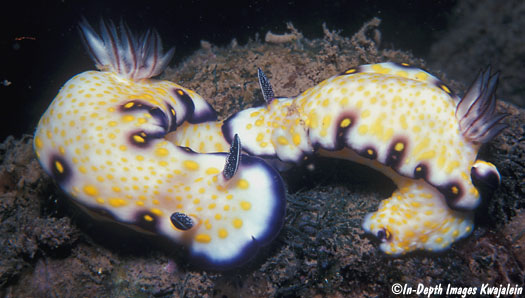
This large and attractive chromodorid nudibranch was a common sight for some years in the Magic Island channel. I dove there frequently to count nudibranchs and for most of that period, this was by far the most abundant species. In my total of more than 50 hours spent counting at this site, I averaged between 25 and 30 individuals an hour between November, 1977, and the end of December, 1982. Due to work away from Hawaii, my next trip to the channel was on 4 February 1984. By then, all specimens of this species were gone. While other nudibranchs were there, I did not find another H. imperialis up to the time I departed Hawaii at the end of 1985, and others I've asked to check the place out for me in the years since then have also come up with none. I'd trade a lot to know why the species disappeared like that. Apparently, they were difficult to find anywhere for some years, but more recently a number of specimens have come up in various sites and reports suggest they are one of the more common species again.

In the channel, this species could often be found eating a turquoise sponge Dysidea fragilis. However, the sponge was often covered with brown silty runoff from the Ala Wai Canal that drained into here.
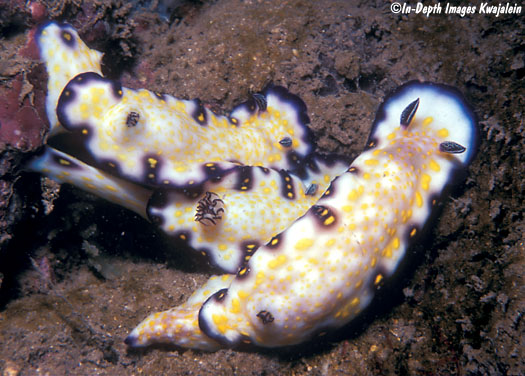
Hypselodoris imperialis was formerly considered in the genus Risbecia (now synonymized with Hypselodoris), and like some other species of Risbecia and a few other groups, are well known to move around by trailing or queuing. A trailing individual would follow another with the anterior end of its foot on the tail of the leader, and they would travel considerable distances this way. Usually this was done in twos, but occasionally you'd find three trailing and in one unusual case described below, I watched four trailing for a short period.

One interesting aspect of these nudibranchs is that individuals could be identified. Along each lateral margin are varying numbers of dark purple-black fingers of color that extend up into the lighter, orange spotted dorsum. Within most of these fingers is one or more orange spots. Given the variability, the patterns were quite unique, much like fingerprints. By counting the orange spots in each finger along both sides, you could develop a code for the species. For example, the left side code for the animal below would be 2-2-1-3-1-1. Sometimes there might be a bit of ambiguity; do you interpret, for example, the small dark indentation between the first two 2's as nothing or a finger with 0 orange spots? But by noting irregularities and recording both sides you could still positively identify individuals. No doubt this pattern changes as the animal develops--the juvenile at the bottom of this page has a code of all zeros. But it was quite useful for the duration of a study Hans Bertsch and I did on movement patterns and behavior. One interesting result of the study was the determination that these little beasts are quite promiscuous. Although nearly always paired, we would often find the pairs mixed up between sampling sessions. They apparently changed partners often. In one case, I watched it happen. Two pairs were moving using their queuing behavior very close to each other and I stopped to watch. Soon the two moving queues collided. In the ensuing mixup, they first formed a short-lived queue of four individuals, which soon broke into two twos that moved off separately. When I checked the codes, I found that they had changed partners in the confusion. I suppose since they are all hermaphrodites, it doesn't matter, but they appear to be not all that discriminating about their partners!
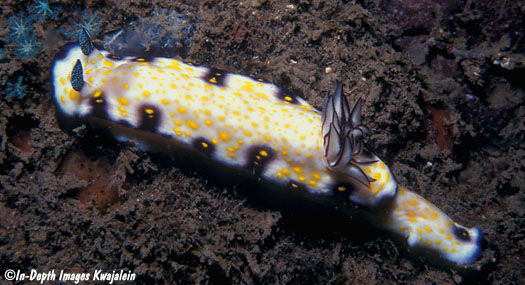
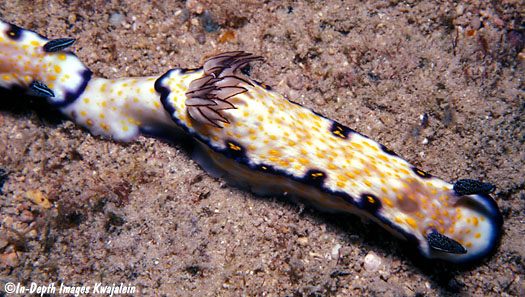
The queue connection close up.
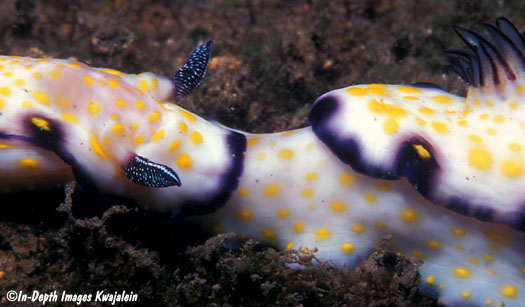
Hypselodoris imperialis was named from the Hawaiian Islands. A similar animal that may be Hypselodoris godeffroyana is found in other parts of the Pacific. We have seen and photographed a similar species in the Solomons, and more photos can be found on the Sea Slug Forum. The biggest differences between our H. imperialis and the Solomon Island species seem to be the whiter dorsal background and larger, more yellow (rather than orange) spots over the white in H. imperialis. The Solomon's species seems to have brown or purple as a dorsal background color and smaller, more numerous orange spots. But then what can we make of the upper animal in the photo below from the Magic Island channel? It seems like it could go either way. The vast majority of H. imperialis we saw in Hawaii (and one specimen in the Marshalls) were colored like the lower one below and those in the other photos on this page. But occasionally one like the upper one below would turn up. It's just one more question to examine in more detail sometime.
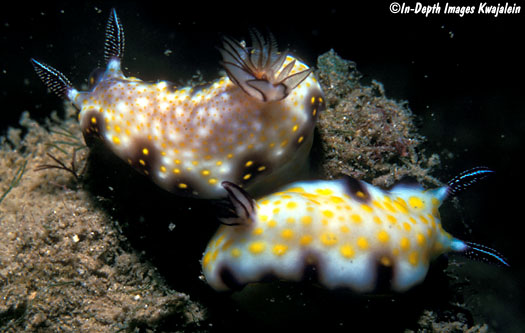
The two below are young, small specimens. The upper one is feeding on Dysidea.
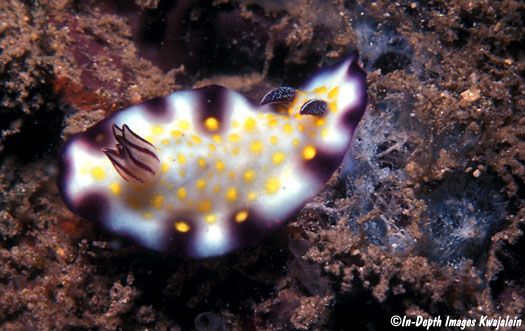
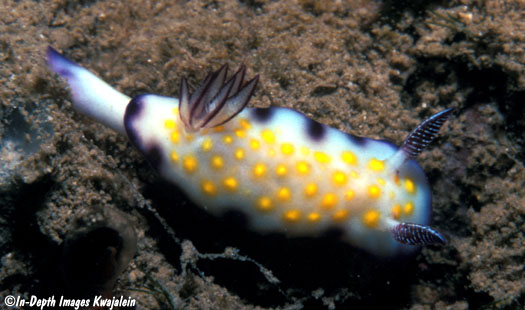
Created 20 April 2009
Updated 1 July 2012